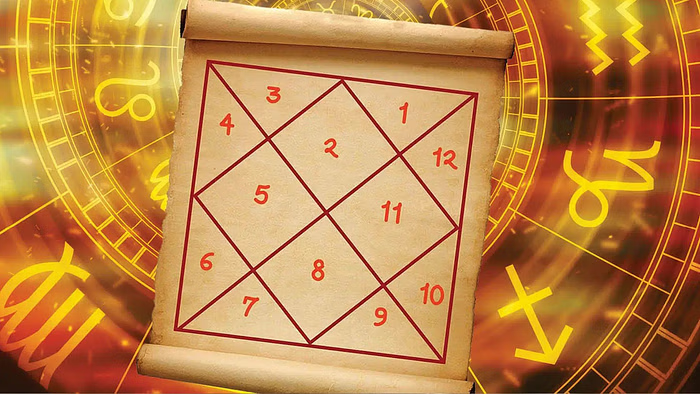
What is Kundli Chart
A Kundli chart, also known as a birth chart or Janam Kundali, is a snapshot of the celestial positions at the exact time and place of your birth. It's a fundamental tool in Vedic astrology, offering insights into your personality, life path, potential, and challenges. Reading a Kundli involves understanding several key components:
1. The Ascendant (Lagna)
- The Most Important Point: The ascendant is the zodiac sign that was rising on the eastern horizon at the time of your birth. It's the first house of your Kundli and is crucial because it shapes your overall personality, physical appearance, and how you interact with the world.
- Finding the Ascendant: In most Kundli charts, the first house is located at the bottom left. The zodiac sign (represented by a number) in this house is your ascendant sign.
2. The 12 Houses (Bhavas)
- Spheres of Life: The Kundli is divided into 12 houses, each representing different aspects of your life. Think of them as different rooms in a house, each with a specific theme.
- 1st House (Ascendant): Self, personality, physical appearance, vitality.
- 2nd House: Wealth, finances, family, speech, values.
- 3rd House: Siblings, communication, courage, short journeys, skills.
- 4th House: Home, mother, happiness, property, vehicles, emotions.
- 5th House: Children, creativity, romance, education, speculation, past life merits.
- 6th House: Health, enemies, obstacles, debts, service, daily routine.
- 7th House: Marriage, partnerships, spouse, business relationships, public image.
- 8th House: Longevity, death, transformation, inheritance, occult sciences, sudden events.
- 9th House: Father, religion, philosophy, higher education, luck, long journeys, गुरु (guru).
- 10th House: Career, profession, social status, ambition, karma.
- 11th House: Gains, income, friendships, elder siblings, aspirations.
- 12th House: Expenses, losses, spirituality, foreign lands, liberation, subconscious.
- House Lords: Each house is ruled by a zodiac sign, and therefore a planet (the lord of that sign). The placement of this ruling planet influences the affairs of that house.
3. The Planets (Grahas)
- Cosmic Influencers: The nine planets (Sun, Moon, Mars, Mercury, Jupiter, Venus, Saturn, Rahu, and Ketu) are placed in different houses and signs in your Kundli at the time of your birth. Each planet represents specific energies and influences different areas of your life depending on its placement.
- Sun: Authority, vitality, ego, leadership.
- Moon: Emotions, mind, sensitivity, nurturing.
- Mars: Energy, courage, action, aggression.
- Mercury: Communication, intellect, learning, adaptability.
- Jupiter: Wisdom, luck, expansion, optimism, spirituality.
- Venus: Love, relationships, beauty, harmony, pleasure.
- Saturn: Discipline, responsibility, limitations, hard work, delays.
- Rahu (North Node): Ambition, desire, illusion, karmic imbalances from the past.
- Ketu (South Node): Detachment, spirituality, past life talents, liberation.
- Planetary Relationships: Planets can have friendly, inimical, or neutral relationships with each other. This influences how they interact and affect the houses they occupy or aspect.
- Exaltation and Debilitation: Planets feel more comfortable and give strong positive results in certain signs (exaltation) and uncomfortable and give weaker or negative results in other signs (debilitation).
4. Zodiac Signs (Rashis)
- Celestial Backdrop: The 12 zodiac signs (Aries, Taurus, Gemini, Cancer, Leo, Virgo, Libra, Scorpio, Sagittarius, Capricorn, Aquarius, Pisces) represent different archetypes, characteristics, and energies. Each house contains one zodiac sign.
- Sign Lords: Each zodiac sign is ruled by a specific planet.
5. Planetary Aspects (Drishti)
- Energy Projection: Planets cast "aspects" or special gazes on other houses and planets, influencing them with their energy. The most common aspects are 7th house (opposite), 5th and 9th houses (trines), and 4th and 8th houses (squares). Mars, Jupiter, and Saturn have additional special aspects.
Steps to Begin Reading a Kundli:
- Identify Your Ascendant Sign (Lagna): This is the most crucial step as it forms the basis of your entire chart. Find the sign in the first house.
- Understand the Houses: Familiarize yourself with what each of the 12 houses represents in your life.
- Check Planetary Positions: See which planets are placed in which houses and signs. Note the ruler of each sign and the lord of each house.
- Analyze Planetary Relationships: Consider the natural and temporary relationships between the planets in your chart. Are they friends, enemies, or neutral?
- Understand Planetary Aspects: Identify which planets are aspecting which houses and other planets.
- Consider Exaltation and Debilitation: Note if any planets are in their signs of exaltation or debilitation.
Important Considerations:
- Dasha System: Vedic astrology uses a system of planetary periods called "dashas" which show which planet's influence is dominant at different times in your life. Understanding your current and upcoming dashas is crucial for timing events.
- Yogas: Specific combinations of planetary placements create "yogas," which can indicate fortunate or challenging periods and specific traits.
- Transits (Gochar): The current movement of planets in the sky and their interaction with your natal chart (the Kundli) are used to make predictions about present and future events.
Learning to read a Kundli is a complex process that takes time and dedication. While you can learn the basics, a thorough and accurate interpretation often requires the expertise of a knowledgeable astrologer who can synthesize all the different elements of the chart.
Start by familiarizing yourself with the signs, houses, and planets and their basic significations. Online resources and books can be helpful, but consulting a qualified Vedic astrologer will provide a personalized and in-depth understanding of your birth chart.




